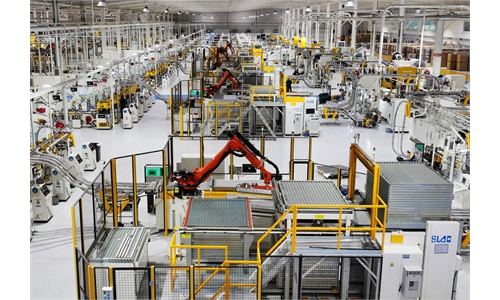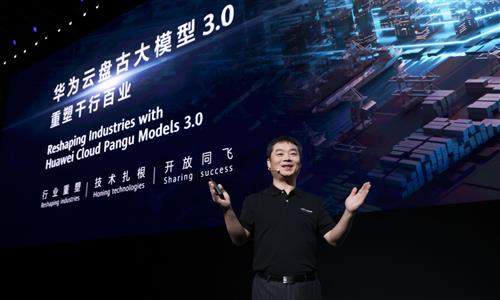
A concept photo of AI healthcare Photo: VCG
China's development of artificial intelligence (AI) has made strides since early 2023, as the revolutionary technology is increasingly being used in nearly all industrial and service segments now, though not at full-fledged magnitude yet.There are international investment organizations which estimate that, by 2030, the AI technology will deliver about $8 trillion to China's GDP, as compared with roughly $5 trillion added value for the US economy.
The research and innovation prowess displayed by Huawei Technologies in leading the AI exploration, and integrating its AI solutions with a wide range of industrial fields in China has made the difference. For example, four Chinese automakers, based respectively in Anhui Province's Hefei and Wuhu, Beijing and Chongqing, are chosen by Huawei to produce internet-connected smart electric cars that are armed with Huawei's latest AI software. Their vehicles are the best-sellers among Chinese consumers now.
Despite facing the most relentless crackdown and suppression from the US, Huawei did not budge or surrender, but focused on indigenous innovation. The tech giant has emerged as the key supplier of advanced AI chips after Washington implemented export curbs on Nvidia's GPU processors. Currently, Huawei's core tech trains AI models at 1.1 times faster than popular GPUs.
Huawei's proprietary Pangu AI models are serving a flurry of industry-specific needs, as the company vows to help Chinese enterprises and governments at varied levels to use Pangu large models to solve problems and ramp up efficiency in ways never seen before. Currently, Huawei's Pangu AI models are proliferating to cover nearly all aspects of the national economy, including Pangu Mining Model, Pangu Manufacturing Model, Pangu Drug Molecule Model, Pangu Port Model, Pangu Railway Model, Pangu Telecom Model, Pangu Finance Model, Pangu Government Model, Pangu Meterology Model and more.
As China is making fresh pushes to vigorously develop new quality productive forces, Huawei's Pangu series of AI solutions will showcase its great capability.
The Pangu Mining Model has been used at eight coal mines in China. A single model can support more than 1,000 sub-scenarios for coal mining, including digging, equipment control, transport, ventilation, coal washing and more. It helps to build safer, more intelligent mines that can run efficiently with just a small underground crew or even no underground crew at all. As a result, the mining efficiency has significantly increased now.
The Pangu Manufacturing Model, pre-trained on data about parts and components, business processes, and rules from Huawei's own production lines, is capable of accurate intent understanding. By calling the Huawei OptVerse AI Solver plugin, the Pangu Manufacturing Model can develop a 3-day production plan in just 1 minute.
The Pangu Railway Model can accurately identify 67 types of freight cars and over 430 types of faults found on railways and freight cars. The model can quickly scan millions of images captured by the railway TFDS system and filter out 95 percent of the images that are fault-free. This way, train inspectors can focus on the remaining images, and this helps them improve both efficiency and accuracy.
The Pangu Virtual Human Model that supports model generation and model control, trained with 200,000 hours of video and audio data. Model generation and control enable easily building virtual humans for online education, entertainment, live-streaming, meetings and more.
And, developing a new drug used to take up to 10 years and a massive cost. Now, Huawei's Pangu Drug Molecule Model is able to accelerate lead compound discovery from several years to one month, reducing drug R&D costs by 70 percent. For instance, relying on this model, a team led by Professor Liu Bing of Xi'an Jiaotong University discovered a new super-antibiotic — the first new antibiotic to be discovered in 40 years with brand-new protein targets.
The Pangu Meteorology Model is the first AI model to have surpassed state-of-the-art numerical weather prediction method in terms of accuracy. The prediction speed is much faster. In the past, predicting the trajectory of a typhoon over 10 days took 4 to 5 hours of simulation on a high-performance cluster of 3,000 servers. Now, the Pangu model can do it in 10 seconds, and with more accurate results.
The Pangu Government Model has been trained on more than 200,000 government data records, covering government policy documents, government encyclopedia knowledge bases, government hotline data, and other common knowledge, so it has extensive knowledge on government policies, regulations, and government service processes.
The Pangu Finance Model, pre-trained on large datasets containing data about bank policies, procedures and case studies, can automatically generate the correct service workflows and guides for bank tellers based on the customers' service requests. This helps them handle service requests more efficiently. Essentially, Pangu Finance Model has given each bank employee their own personal intelligent assistant.
Lately, Huawei has just introduced its latest AI innovations to upgrade telecom network capabilities at case-, process-, and system-levels, which significantly accelerate network intelligence. "We believe network innovation in the 5.5G era covers two aspects: AI for networks and networks for AI," a company statement said.
Huawei is the leader of 5G mobile networks. Huawei has pioneered in applying network intelligence technologies to the data communication field. And now, AI-powered high-speed mobile network solutions accurately meet the needs of intelligent networks and, more importantly, turbocharge AI training and maximize the transmission capacity of intelligent computing.
The company's 5.5G Converged WAN - featuring high throughput, high elasticity and highly guaranteed performance - offers intelligent transmission capacity, which enables intelligent defense and increases network operational efficiency by 100 times. As China's mobile networks are incessantly upgraded, the magnitude of connections and the connecting speed will make more innovations and actual use scenarios possible.
It is true that Huawei, despite facing US government suppression, has made miraculous breakthroughs in fields from mobile networking, high-end chips, the operating systems to artificial intelligence, and it had taken the company just about 10 years to do what the US took 30 years to achieve.
The author is an editor with the Global Times. bizopinion@globaltimes.com.cn



